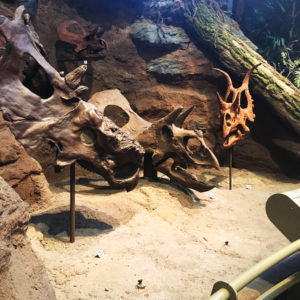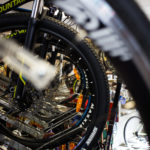Prehistoric Giants Roam the Halls of the Carnegie

Visitors to the “Dinosaurs in Their Time” exhibit are able to wander through towering displays featuring fossils of the bygone creatures.
words: Nina Saluga
photos: Nina Saluga
The “Dinosaurs in Their Time” exhibit at the Carnegie Museum of Natural History, situated at the foot of Craig Street, is a cavernous funhouse for students, small children and paleontologists alike.
Little ones wander the exhibit wide-eyed and curious, watching the animated museum guides recount riveting tales of the menacing creatures that roamed the Earth nearly 65 million years ago. Meanwhile, parents peruse the extensive collection of dinosaur relics, silently hoping to make it out of the grandiose gift shop at the exhibit’s entrance with their pocketbooks unscathed.
“Dinosaurs in Their Time” is a gift from one of Pittsburgh’s most remarkable figures, Andrew Carnegie. It is home to the T-Rex holotype, one of the most extensive fossil collections in the world and the Diplodocus equivalent of Carnegie himself, at least by name.
The exhibit is complete with an interactive fossil dig, “Bonehunters Quarry,” where children shriek happily as they romp through the backyard of their dreams, gleefully “unearthing” remains from the creatures they have only come into contact with in bedtime stories.
 The “Dinosaurs in Their Time” exhibit is a unique time-travel experience where visitors travel through the prehistoric era when dinosaurs roved the Earth. Afterward, they can grab a quick cup of coffee just outside at The Bagel Factory or a sushi roll from Sushi Fuku afterward.
The “Dinosaurs in Their Time” exhibit is a unique time-travel experience where visitors travel through the prehistoric era when dinosaurs roved the Earth. Afterward, they can grab a quick cup of coffee just outside at The Bagel Factory or a sushi roll from Sushi Fuku afterward.
It is a distinctly Oakland experience at its finest, where visitors are likely to bump into other neighborhood residents as well as international and prehistoric characters alike.
There are plenty of dinosaurs to meet inside, but there’s one that guests will meet exclusively at the Carnegie Museum of Natural History, says Mallory Vopal, the gallery experience manager.
“We have lots of really amazing specimens that are found only here, for example we have the T-Rex holotype which is the very first T-Rex ever found,” Vopal says. “You can only find the T-Rex for the first time once, and so the fact that we have the very first T-Rex found here is amazing.”
Among the other notable characters that reside in the museum’s chamber is a household name in Oakland, and that’s Andrew Carnegie himself. Sort of.
“We have Diplodocus carnegii, which is named after Andrew Carnegie, and then we have a Apatosaurus louisae which is right next to it, and the two dinosaurs are looking at each other,” Vopal says. “Louise was his wife, so it’s Andrew Carnegie and his wife forever memorialized as two dinosaurs in our dinosaur hall.”
Nestled just beyond the gift shop and among the Hillman Hall of Minerals, the Benedum Hall of Geology and the PaleoLab Fossil Preparation Center, the “Dinosaurs in Their Time” exhibit is housed in a chamber with soaring ceilings and pale blue walls that serve as the backdrop to prehistoric times.
 Dinosaurs hover vigilantly as they keep watch over the exhibit. It’s hard to tell if the massive creatures are smiling or hungry as they loom high above visitors’ heads. Intricate Mesozoic murals span the length of the walls, looming in the backdrop as to make the authentic, reassembled dinosaur bones the starring attraction.
Dinosaurs hover vigilantly as they keep watch over the exhibit. It’s hard to tell if the massive creatures are smiling or hungry as they loom high above visitors’ heads. Intricate Mesozoic murals span the length of the walls, looming in the backdrop as to make the authentic, reassembled dinosaur bones the starring attraction.
The Carnegie Museum of Natural History is a cornerstone of Oakland’s identity. The museum and its exhibits, like “Dinosaurs in Their Time,” magnify the remarkable collection of educational and cultural institutions the neighborhood houses.
“Oakland is an amazing area because of all of the institutions of higher learning, but also because we’ve got the Carnegie Museum of Natural History, Carnegie Museum of Art, there’s Phipp’s Conservatory, there’s Soldiers and Sailors Hall,” Vopal says. “There’s so many amazing institutions just in such a small concentrated area … Oakland is just a really special part of Pittsburgh for the amazing higher learning opportunities that are just right here.”
Apart from bolstering educational and cultural opportunities in the neighborhood, the Carnegie Museum of Natural History and its exhibits are unbeatable tourist attractions. The extensive collections of archival material and afterhours programs encourage frequent visits from tourists and locals alike.
The museum’s “After Dark” events are popular among students and tourists, and are held five times per year. “After Dark” events happen when the museum opens its doors afterhours to accommodate guests for a 21 and up bash with live music, a bar and exhibits curated to give guests a uniquely afterhours experience.
The museum and its events bring in visitors of all kinds, from Pittsburgh natives to dinosaur enthusiasts, children, students and international tourists. The dinosaurs that reside at the “Dinosaurs in Their Time” exhibit are some of the most sociable creatures in the area, making new friends and welcoming old ones back daily.
 They are often visited by first-timers like Melanie Perry, a native of Tasmania who also sees the Carnegie Museum of Natural History as an invaluable asset to the Oakland community.
They are often visited by first-timers like Melanie Perry, a native of Tasmania who also sees the Carnegie Museum of Natural History as an invaluable asset to the Oakland community.
“Things like this are always really good for the community,” Perry says. “Where I live in Tasmania, we just had a new modern museum open and they have heaps of events and it brings lots of people. So, I think it is really important, and it brings in tourists and people that are interested.”
Mike Alexandersen and Rosemary Pike grew up in Pittsburgh but now live in Taiwan. A visit to the Carnegie Museum of Natural History was at the top of their list of homecoming activities. Pike and Alexandersen see the museum as a powerful resource for tourism in Oakland.
“It certainly brings in people basically just to see it; that’s why we came in today,” Pike says.
Alexandersen adds, “It means that we spent money at a restaurant.”
 Previous Post
Previous Post Next Post
Next Post